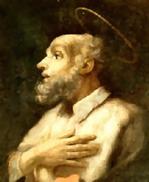Catechism of the Catholic Church
1217 In the liturgy of the Easter Vigil, during the blessing of the baptismal water, the Church solemnly commemorates the great events in salvation history that already prefigured the mystery of Baptism:
Father, you give us grace through sacramental signs
which tell us of the wonders of your unseen power.In Baptism we use your gift of water,
which you have made a rich symbol
of the grace you give us in this sacrament. 11
1218 Since the beginning of the world, water, so humble and wonderful a creature, has been the source of life and fruitfulness. Sacred Scripture sees it as "oveshadowed" by the Spirit of God: 12
At the very dawn of creation
your Spirit breathed on the waters,
making them the wellspring of all holiness. 13
1219 The Church has seen in Noah's ark a prefiguring of salvation by Baptism, for by it "a few, that is, eight persons, were saved through water": 14
The waters of the great flood
you made a sign of the waters of Baptism,
that make an end of sin and a new beginning of goodness. 15
1220 If water springing up from the earth symbolizes life, the water of the sea is a symbol of death and so can represent the mystery of the cross. By this symbolism Baptism signifies communion with Christ's death.
1221 But above all, the crossing of the Red Sea, literally the liberation of Israel from the slavery of Egypt, announces the liberation wrought by Baptism:
You freed the children of Abraham from the slavery of Pharaoh,
bringing them dry-shod through the waters of the Red Sea,
to be an image of the people set free in Baptism. 16
1222 Finally, Baptism is prefigured in the crossing of the Jordan River by which the People of God received the gift of the land promised to Abraham's descendants, an image of eternal life. The promise of this blessed inheritance is fulfilled in the New Covenant.
1223 All the Old Covenant prefigurations find their fulfillment in Christ Jesus. He begins his public life after having himself baptized by St. John the Baptist in the Jordan. 17 After his resurrection Christ gives this mission to his apostles: "Go therefore and make disciples of all nations, baptizing them in the name of the Father and of the Son and of the Holy Spirit, teaching them to observe all that I have commanded you." 18
1224 Our Lord voluntarily submitted himself to the baptism of St. John, intended for sinners, in order to "fulfill all righteousness." 19 Jesus' gesture is a manifestation of his self-emptying. 20 The Spirit who had hovered over the waters of the first creation descended then on the Christ as a prelude of the new creation, and the Father revealed Jesus as his "beloved Son." 21
1225 In his Passover Christ opened to all men the fountain of Baptism. He had already spoken of his Passion, which he was about to suffer in Jerusalem, as a "Baptism" with which he had to be baptized. 22 The blood and water that flowed from the pierced side of the crucified Jesus are types of Baptism and the Eucharist, the sacraments of new life. 23 From then on, it is possible "to be born of water and the Spirit" 24 in order to enter the Kingdom of God.
See where you are baptized, see where Baptism comes from, if not from the cross of Christ, from his death. There is the whole mystery: he died for you. In him you are redeemed, in him you are saved. 25
1226 From the very day of Pentecost the Church has celebrated and administered holy Baptism. Indeed St. Peter declares to the crowd astounded by his preaching: "Repent, and be baptized every one of you in the name of Jesus Christ for the forgiveness of your sins; and you shall receive the gift of the Holy Spirit." 26 The apostles and their collaborators offer Baptism to anyone who believed in Jesus: Jews, the God-fearing, pagans. 27 Always, Baptism is seen as connected with faith: "Believe in the Lord Jesus, and you will be saved, you and your household," St. Paul declared to his jailer in Philippi. And the narrative continues, the jailer "was baptized at once, with all his family." 28
1227 According to the Apostle Paul, the believer enters through Baptism into communion with Christ's death, is buried with him, and rises with him:
Do you not know that all of us who have been baptized into Christ Jesus were baptized into his death? We were buried therefore with him by baptism into death, so that as Christ was raised from the dead by the glory of the Father, we too might walk in newness of life. 29
The baptized have "put on Christ." 30 Through the Holy Spirit, Baptism is a bath that purifies, justifies, and sanctifies. 31
1228 Hence Baptism is a bath of water in which the "imperishable seed" of the Word of God produces its life-giving effect. 32 St. Augustine says of Baptism: "The word is brought to the material element, and it becomes a sacrament." 33
Notes:
English Translation of the Cathechism of the Catholic Church for the United States of America © 1997, United States Catholic Conference, Inc.






